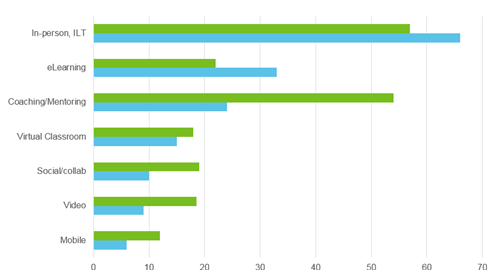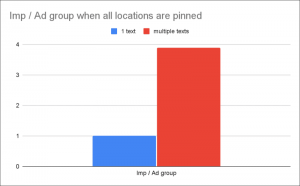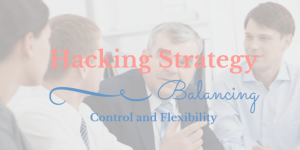Last month at Excellence 2016, Brandon Hall’s annual conference, Dave Wentworth, their principle learning analyst, shared the results of their 2015 survey of L&D professionals. The results I found most interesting compared usage and effectiveness of nearly two dozen modes of delivery. Below is a chart listing several of these categories.
If you are looking to fine-tune your learning strategy, this chart offers a number of suggestions. My assumption is that you’d want to have usage and effectiveness roughly equal, but that’s not the case for most of the modalities.
1) Reduce ILT and eLearning
For two of the most popular modes of delivery — instructor-led and eLearning — effectiveness trailed usage. These two modes are the army mules of instruction, carrying the bulk of training to our learners. However, they have their shortcomings:
- In-person, instructor-led training can be expensive, especially to when you need to reach hundreds or thousands of learners.
- eLearning scales up well, but for many learners, the lack of human touch compounded with too many uninspiring e-lessons gets the learner focusing on completion, not learning.
However, these two scored highest on usage, and they certainly have their merits. For ILT, the truth is that a good instructor will engage the audience and personalize the material to suit the needs of the group. And for eLearning, a well-crafted module can be a wonderful learning experience: learners can proceed at their own pace and practice until they have mastered the material. While they often still are the best way to solve a learning problem, the data suggests we rely on them too much.
2) Add Coaches and Mentors
If we were to reduce the usage of ILT and eLearning, what might we add? I’d start with the next modality in terms of usage — coaching and mentoring. It has the biggest gap, where effectiveness more than doubles usage. We’ve seen customers augment their learning programs with mentors and coaches who answer questions, offer encouragement and help the learner see connections to their work. The impact can be enormous. For one customer, prior to having access to coaches, the completion rates of their soft skills programs, which were a series of eLearning modules, were dismal — under 20%. After adding coaching, completion rates rose to close to 80%. Of course, a coaching and mentoring programs take some planning, and here’s an eBook with some ideas to get your started.
3) Shift to Virtual Classroom
Virtual classroom, along with the other modalities (social/collaboration tools, video, and mobile learning) also scored higher on effectiveness than usage. If you’re training relies heavily on live instruction, virtual classroom is a great alternative, as it offers greater convenience for instructors and students alike, and the savings on time and money spent traveling can be sizable. However, you need to actively engage learners or they will be too easily distracted. Here’s a recorded webinar with a number of ways to make virtual classroom sessions engaging.
4) Start Experimenting with Modern Learning Tools
Social and collaboration tools, along with video and mobile learning, all enable learners to “pull” what they need, when they need it. These modalities are at the core of modernizing learning programs, and if you haven’t started experimenting with these tools, you need to.
- Social and collaboration tools. Some organizations, where collaboration and openness are highly valued, see a rapid uptick in social communities and discussions. Others need to take a more gradual approach, choosing specific groups and building an online learning community to meet their needs. This short topic brief will give a few ideas on where to start.
- Video learning. Video learning here is defined as short videos (ideally less than two minutes) that cover a specific best practice or how-to. They need to be tagged or indexed, so learners can find them by searching in the moment of need. Often they are created by employees, and we’re seeing a growing movement among our customers for encouraging everyone to share their genius.
- Mobile learning. Mobile learning is critical not only for those on the go, such as your sales and service people, but also for providing greater flexibility for the rest of your employees. When you consider YouTube and Facebook are incredibly popular on phones and tablets, it’s not surprising that video and social learning work great there too — just be sure searching and crowdsourcing are easy to do. But mobile access can be valuable in nearly all the modalities* — you can connect with your coach or mentor, access a virtual classroom when away from the office, or download that eLearning module and complete it when you’ve got a few minutes. (*For your instructor’s sanity, please put the phone away when class is in session!)
There are many different ways to go about improving your organization’s learning strategy. If one of the suggestions mentioned above appeals to you, then jump in. If you’re not so sure, you might want to survey those involved with your learning programs and ask them to rate the usage and effectiveness of each of your modes of delivery. With a chart like the one above that’s specific to your organization, you’ll have a pretty good idea of what to prioritize.
Business & Finance Articles on Business 2 Community(63)








